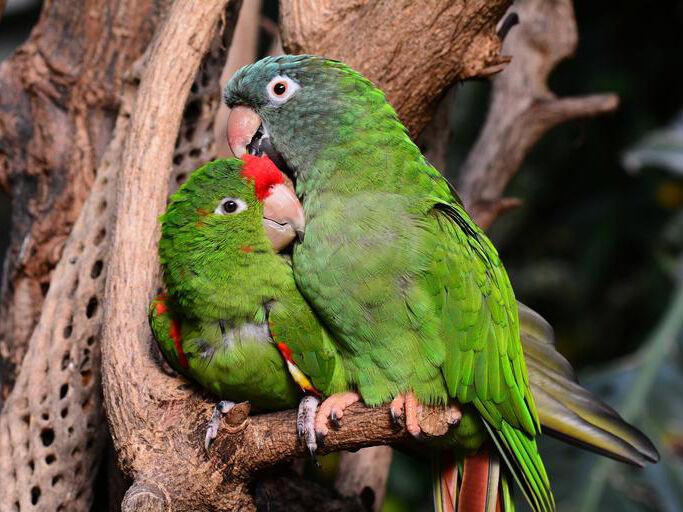
While the bond between an animal and their human is important, considering the relationships between pets — in both interspecies and same species interactions — also is an important part of making sure your home is a happy and healthy environment.
Some bird species, including parrots, chickens, canaries and pigeons, are very flock oriented and are often adopted and kept in groups.
Dr. Sharman Hoppes, a professor emerita affiliated with the Schubot Center for Avian Health at the Texas A&M College of Veterinary Medicine & Biomedical Sciences, said “birds are flock animals, and we need to recognize that when we adopt one. A bird in the wild would never be left alone, so being alone all day in a cage can be stressful.”
Debra Turner, aviary manager of the Schubot Center, says that when adopting multiple birds, owners should be mindful of the relationships between their birds to ensure a safe environment.
“Subtle signs of a not overly happy pair of birds might be each sitting on opposite ends of a perch or the dominant bird not letting the other bird perch at the same height,” Turner said. “The dominant bird may also not let the other bird approach the food dish and, in the worst-case scenario, outright physically attack the other bird.
“Some birds might not ever get along and two cages would be the best option for them,” she said. “They could come out for playtime, but each would have their own ‘home’ to return to.”
When introducing a second bird, the new bird should receive a health examination from a veterinarian before entering the house or room where your current bird resides. The veterinarian will test for diseases like Chlamydia, which also affects humans; Psittacine Beak and Feather; or Avian bornavirus.
“Once the new bird arrives, house the bird in a separate cage and adjust proximity to the current bird to start acclimation,” Turner said. “Over time, the pair will become used to each other and eventually may be housed together. The inside of a pet birdcage is a microenvironment that is very near and dear to a bird, who could display possessive nature toward their home space.
“When introducing two birds together, a new cage, or an old cage that has been thoroughly cleaned with perching and toys repositioned, would be helpful to reduce the possessive tendencies of one bird against the new bird entering the space,” she said.
An owner may choose to adopt only one bird, in which case it is important that the bird flying solo spends time in the presence of people and other pets (such as dogs and cats), which it may see as part of its flock.
It is also important to provide the bird with activities, such as toys, the opportunity to forage for food, and other forms of enrichment, to keep them busy when alone.
Although birds may form positive social relationships with the other animal members of their household, it is important to remember that birds are prey animals and should not be left alone when out of their cage around even the most well-meaning dog or cat. Mediating interactions between pets reduces the risk of either animal getting hurt.
Turner also says that owners should position their bird’s enclosure out of reach from exploring dogs and cats. This can help reduce stress for your bird and prevent an accidentally tipped cage.
“Birds are highly intelligent creatures who need stimulation and enrichment, as with any other pet, for their mental and physical well-being,” Turner said.
“In the right home, a bird can be your best friend and one of your longest relationships, but they are very high-maintenance pet to keep healthy and happy,” Hoppes said. “Before you get a bird, you should do research on the type of bird and their specific needs and have a relationship with a veterinarian comfortable caring for your bird.”
"bird" - Google News
March 28, 2021 at 06:00PM
https://ift.tt/3w4wXzF
PET TALK: Birds of a feather flock together: Social behaviors of birds, Part 2 - Paris News
"bird" - Google News
https://ift.tt/2s1zYEq
https://ift.tt/3dbExxU
Bagikan Berita Ini














0 Response to "PET TALK: Birds of a feather flock together: Social behaviors of birds, Part 2 - Paris News"
Post a Comment